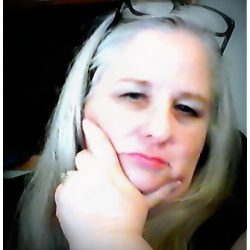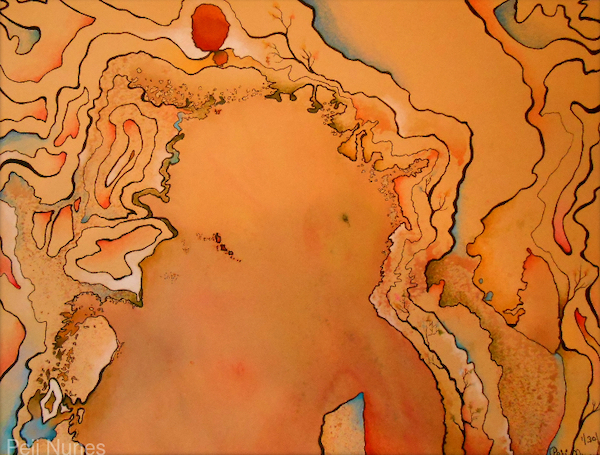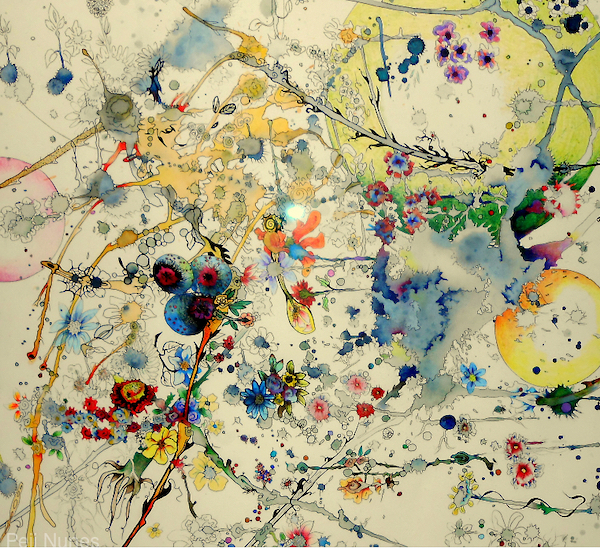Through her own life experiences, Pejj Nunes realized something important about herself and how she might help other people: “That I could bring people together for a good cause; that I could research, develop something that would have a good outcome for other people.”
For example, when her daughter was diagnosed with Tourette Syndrome at the age of seven, Pejj discovered there was little to no information readily available about the disease. So … she did her own research and quickly became an advocate, not only for her daughter but for other families, as well.
Pejj is also an artist. Several years ago, she began to develop the Shibui Found Image Art Project. She has been creating art for most of her life, but Shibui Found Image Art spoke to her in a different way. “Shibui comes from the imagination and is unique to those creating it,” she explains.
According to Wikipedia, Shibui is a Japanese word which refers to a “particular aesthetic of simple, subtle, and unobtrusive beauty.”
- Shibui objects appear to be simple overall but they include subtle details, such as textures, that balance simplicity with complexity.
- This balance of simplicity and complexity ensures that one does not tire of a Shibui object but constantly finds new meanings and enriched beauty that cause its aesthetic value to grow over the years.
Pejj realized that Shibui Found Image Art could be a powerful form of art therapy and decided that she wanted to teach her method. Well … it’s one thing to have a great idea and another to execute it. Life was already presenting some challenges and then along came COVID-19. As I read her essay about coping during the pandemic, I was struck by her passion and her determination. I also loved her work. I’d never heard of Shibui before, and now I find myself staring at each piece, looking for meanings, wondering how she did each one, following the lines, the shapes, the colors. It’s like a form of meditation. I can’t wait to try making something myself, with guidance from Pejj, although as you will read, for right now, not face to face.
This is Pejj’s story:
My name is Pejj Nunes. I’ve been an artist for many years. I live in Hollis, Maine and my studio’s name is Anisette Studios. I struggle to meet our needs like so many other people do. My recently retired husband Tom is not well, he has had strokes and been very lucky in that he has come out of having them as well as he has! I could have lost him about four times! At this age I could still lose him, so what do I do about me and how to move forward? Many women of my age face such issues. I need a purpose in life to live fully. Thomas also has had heart surgery and lung issues. At this time I need to help him with his health issues and I am also taking care of my grandson who is a fragile diabetic. His mom is in the thick of things where she works as an LPN in Rhode Island. Well, when things seem tough, the tough had best figure it out!
I know I need to take care of me so I can take care of Thomas and our Alex at this time. The question is how to keep me healthy? The mind is the first step as it talks to the soul and body. My art and writing keep me sane. I have a great love and desire to help so many other people, especially at this time. The way the world is saddens me greatly. So much ugliness coming out of the woodwork. Find your positive! Be safe! There are many things I can’t do but there are many things I can do that will make my life worthwhile. I can help others. I can do something to make a difference.
The reason that COVID really panicked me was because of my financial concerns. Retirement is not the same pay rate as a full-time job. So I asked myself what can I do? I have a retired and ill hubby. What will make life feel worthwhile at this time so I can take care of me? Because if something happens to me … I asked myself, how can I make a difference? How can life be worthwhile?
I did have plans prior to COVID and asked myself how I could still do those things? Those plans had been to turn our garage into a larger teaching studio. I would teach Shibui as an art and as a therapeutic tool by teaching a certification course. The course would create art-related jobs where people could teach the foundation as I am. I could point them in the right direction so they would learn the art of being an art entrepreneur. I could court my target groups!
More questions to answer. How do I reach people and do this safely as a revenue stream during COVID? I thought I can at least prepare for when COVID does end by getting the word out and showing people what Shibui Found Image Art is. I can teach using Zoom and Facebook like I already do with my business labs and friends.
In the beginning, I will be offering some free videos, especially as I get comfortable with teaching live. I am also writing new blogs, newsletters, and articles about Shibui Found Image Art. What has happened has delighted me! I am being noticed by my target groups on LinkedIn. People are reading my new blogs and they are checking out my website! I am obtaining what I need to teach! I am down to getting a mic. Being home, exploring how to do this is turning out to be very exciting! There is much hope in taking action. I had been away for a couple of years helping my daughter become an LPN. While away I continued to work on what I wanted Anisette and Shibui to be. Now here I am!
In 2011 the artwork I had been doing changed. I wanted to do something different! So out of a personal need, I put Reeves BFK printmaking paper on the floor and began to splatter, sprinkle, to create runs of watercolor dip and turn on the papers surface. I blotted this, added darker tints of color. I learned I could bleed color into colors. I let these dry and came back. I said out loud to no one but the room. “Now! What’s there?” Much to my delight, there was a lot “there!” My journey began! Right away I felt that anyone could do this. It’s like finding things in the cloud or a stain. But there is much more to this creative process. Shibui Found Image Art comes from the imagination. There is no under-structure. This too comes from the imagination. Shibui makes up its own rules of creation. It all begins with the eye, and how the eye sees! Then the mind becomes involved, and once the mind is involved, so is the rest of the body. This understanding is key to how Shibui can work as a therapeutic tool.
I began to develop Shibui Found Image Art’s foundations because of what creating Shibui taught me. The process is one of solving a puzzle. Shibui rules if you will come to mind as the Shibui is worked. It begins with the choice of paper and colors of the wet mediums. These are watercolor, India Ink, watered-down acrylic paint which is an opaque medium.
Once images are found they are defined by the use of a black Micron pen, 05 or 005 are preferred. Once the edges are defined pastel pencils enhance what is found.
A story unfolds on the paper as is often the case with art. Not only paper but canvas. A Shibuiest goes with what stems from his or her imagination.
Other materials add to the Shibui during the creating process. They may surprise you as they are absorbent materials that can come from your pantry like oatmeal and salt, paper towels, sponges, seeds, etc. Sprinkled on the wet medium and allowed to dry makes for texture on the surface of the paper.
Whatever the approach to finding what is there is unique with each individual creating a Shibui. No two Shibui are the same.
Intentional Shibui work is done to round out the Shibui, but Shibui is distinct for what it is, and what happens with it. A lot happens in the middle of the paper, this means intentional Shibui “marks” for the lack of a better word, need to round the image out so it works in traditional ways.
The viewer of a Shibui will at first see one thing which could be a lovely flower, but as they come closer they will find weird little creatures or fish in a landscape. They will see blotches that the Shibuiest has no choice but to leave because these can not be erased! One rule is “If you can not use it, let it be!” Then how does this work for the sake of the image? Because the eye/mind relationship of the viewer; his or her mind completes the image and then begins to react to “other things”. Shibui calls people closer to find what is there.
Shibui has what is called commonality. This means there are relationships within the watercolor or other wet medium applied through action art onto the papers surface. This commonality is what creates the image in our minds. It creates associations that lead to a story.
Shibui requires letting go and being free in your creative process. I found myself feeling the same pleasure as I did when a child. Shibui is very meditative. But there are techniques to be learned. You do not have to know how to draw. But if you do it will only enhance what you do. You will be better able to imagine the under-structure of what you find.
My goal for Shibui is that it be used as a therapeutic tool. I believe it will help many people stay in their pleasure center. Developing it further I believe I can help them stay in this mode longer. Shibui coming from the imagination differs from traditional art. The new or old Shibuiest is jump-started into creativity.
What do I think can happen with Shibui? I think that people will have a lot of fun with it. They may choose to become a Shibui Artist. Once they learn the foundation they can add to how they process and create a Shibui and its foundation. I would love to see what people do with this! My experience in teaching it so far has been very exciting! Because other individuals approach it as they will. What they are doing is marvelous!
What I need to further develop Shibui is to see what others can do with it. I want to know how it heals and helps people who use it as a therapeutic tool. I want to see what art therapists can do with it. I want to learn how it helps people mentally, emotionally, physically, and spiritually. Art therapy has been around a long time. I feel knowing how the eye translates light and then makes its connections to the mind and then the body is key to how people can heal using art. Maybe if we gain insights into how the mind and the body work in conjunction with creating art, we can finesse it, refine it a bit.
The mind rattles around what goes into short term memory so it is in long term memory. This is what helps us to stay in our pleasure centers so that we heal.
Pejj Nunes
If you would like to learn more about Pejj’s journey and her Shibui Found Image Art Project, visit her website Anisette Studios. She says you can also send her an email or call her at 207-929-6179 if you have any questions or are interested in joining one of her teaching groups. She’s also on Facebook, where you can message her or request to join her Shibui Arts private group to see what other Shibuiests are creating.
Good luck Pejj. I looking forward to meeting you in person some day.






Leave A Comment